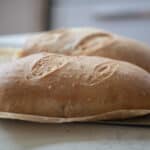
Sourdough Italian Bread
A crusty loaf with a soft crumb and a tasty sourdough kick, Sourdough Italian Bread is delicious, versatile, and has shorter rise times than other loaves, meaning it can easily be ready the same day.
Servings 24
Calories 150kcal
Ingredients
- 6 1/2 cups all-purpose flour 910 g
- 2 1/2 cups water 590 g
- 1/2 cup sourdough starter bubbly and active (113 g)
- 1/4 cup olive oil 60 g
- 1 tablespoon salt 17 g
- 1 tablespoon sugar 12 g
- Egg for egg wash
Instructions
- Feed your starter 4-12 hours prior to beginning the recipe. This will give it the time it needs to be active and bubbly.
- Add the flour, water, sourdough starter, olive oil, salt and sugar to your stand mixer with the dough hook attachment.
- Mix on low speed for 2 minutes, producing a shaggy dough. Increase the mixer speed to medium for an additional 5 minutes, at which point the dough will be pulling away from the sides of the bowl, becoming more elastic and smooth in appearance.
- Here you can test the gluten development with the windowpane test. Pinch off a small portion of the bread dough and use your fingers to pull it into a square shape, observing the center of this square. If it pulls thin enough to allow light through without tearing, your gluten development is satisfactory. If not, continue kneading with the mixer for 2-3 minutes more and try this test again.
- Transfer dough to a well-oiled, large bowl, covered with a tea towel, plastic wrap, or beeswax wrap. You want it to be airtight so no hard skin forms on top of the dough from air exposure.
- Rise until it has doubled in size, approximately 8 hours at room temperature. This may take more or less time depending on the temperature of your home and the maturity of your starter.
Shaping and Second Rise
- After your dough has doubled in size, place it onto a lightly floured work surface and divide in two. I like to use my bench scraper (dough scraper) for this, but a sharp knife works, as well.
- To shape into a torpedo loaf, gently stretch each ball into a long rectangle. Fold each side into the middle, pressing the seam down. Apply tension to the dough by pulling it toward you on the counter, elongating the rectangle so that the shaped dough is about 12" long.
- I like to speed this up by placing it in a warm spot, getting the time closer to the 2 hour mark. This could be in a high place where heat rises, near a heat source like a fireplace hearth, or even in a small room with a space heater.
Alternate fridge rise
- If you're wanting to extend your rise time to better fit your schedule, or for any reason at all (longer fermentation, etc), you can also place your shaped loaves into the fridge at this point. Cover them and refrigerate. You can refrigerate for 12-15 hours (or more), then move forward to scoring and baking.
- Transfer the dough to a baking stone or baking sheet lined with a sheet of parchment paper. Cover dough lightly and let rise until doubled, approximately 2 to 4 hours at room temperature.
Scoring and Baking
- Once doubled, preheat oven to 400 degrees.
- Score the top of the loaves with a bread lame or razor.
- To create steam in the oven, there are several options. See in notes.
- Bake at 400 for 35 minutes until golden brown. Rotating the loaves after about 20 minutes can help you to achieve a more even browning.
- For best results, cool on a wire rack before slicing. However, I do love to enjoy this one warm from the oven, so I may give it a bit of time so that it's not blazing hot, but not fully cooled. Your call!
Notes
Stretch and Fold Method
- Add the flour, water, active sourdough starter, olive oil, salt and sugar to a large mixing bowl and combine with your hands until well incorporated - about 5 minutes. Let the dough rest in the bowl covered with a towel for 30 minutes.
- After the rest and keeping the dough in the bowl, begin your stretch and folds by taking the edge of the dough and pulling it upwards, then folding it back to the center. If the dough is too sticky, try using wet hands.
- Turn the bowl a quarter turn, grab the edge of the dough, stretching and folding again. Repeat this once or twice more, completing one round of stretch and folds.
- You will complete 6 rounds according to the schedule below.
- First 3 stretch and folds – every 15 minutes.
- Final 3 stretch and folds – every 30 minutes.
Creating steam in the oven:
- You can preheat a cast iron or metal pan at the bottom of the oven, adding boiling water to that pan as you begin your bake time. Don't use glass for this, as there's always the risk of it shattering.
- You can place rolled up towels in a ceramic dish, pour boiling water over the top to fully soak the towels, and then place the whole dish of towels in the oven to steam during the bake.
- You can spritz water into the hot oven immediately before baking, shutting the oven door quickly to trap the steam.
- Lastly, you can place a metal pan in your oven to preheat, adding a handful of ice cubes to that pan when you begin baking the bread.
Nutrition
Calories: 150kcal | Carbohydrates: 27g | Protein: 4g | Fat: 3g | Saturated Fat: 0.4g | Polyunsaturated Fat: 0.4g | Monounsaturated Fat: 2g | Sodium: 293mg | Potassium: 36mg | Fiber: 1g | Sugar: 1g | Calcium: 6mg | Iron: 2mg